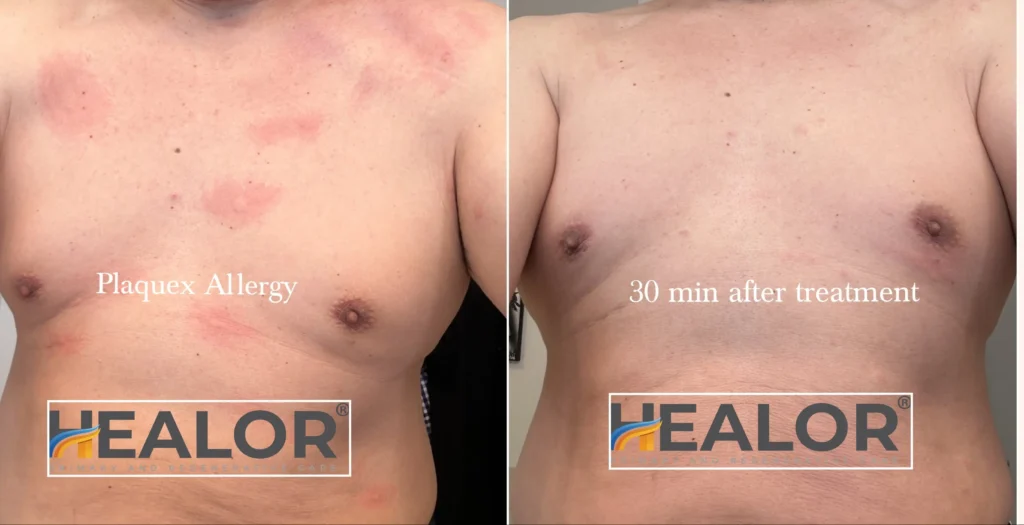
If you’ve heard about Plaquex therapy or are considering it for cardiovascular or other health reasons, you might be curious about potential side effects—particularly plaquex allergy reactions. Although Plaquex has gained traction for its reported benefits in improving lipid profiles, supporting circulatory health, and potentially reducing arterial plaque, it’s important to be aware of the possibility of an allergic response.
In this blog post, we’ll discuss a case involving Plaquex IV infusion and its management.
What is Plaquex?
Plaquex is a proprietary blend often containing phosphatidylcholine (PC)—an essential phospholipid—and other components. This formulation is sometimes administered via intravenous (IV) infusion, particularly in integrative medicine practices, with the goal of:
- Supporting cardiovascular health: Plaquex helps improve blood flow and arterial integrity by enhancing the emulsification and removal of fats from blood vessel walls.
- Lowering coronary calcium scores: Read this blog for detailed article on simple ways to lower yor calcium scores with plaquex.
- Aiding liver detoxification: Phosphatidylcholine can play a role in liver health, as it’s a key component of cell membranes and may aid in lipid transport.
- Hyperlipidemia: Plaquex can lower LDL and Triglyceride levels and boost HDL levels
- General well-being: Users sometimes report improved energy and reduced inflammation.
While research on Plaquex iv is ongoing and not as extensive as that of conventional medical treatments, many patients turn to it as a complementary or alternative option under physician guidance.
What is an Allergic Reaction?
An allergic reaction occurs when the immune system mistakenly identifies a substance (allergen) as harmful and mounts a response against it. Common allergens include foods, pollen, medications, and substances such as intravenous infusions or injections.
When it comes to Plaquex, an allergy could be triggered by:
- Phosphatidylcholine itself, if a patient has a specific sensitivity.
- Additives or excipients in the Plaquex formulation, which can vary depending on the manufacturer.
- Contaminants or other ingredients if the product is not from a reputable source or if it’s mixed with other substances.
Signs and Symptoms of a Plaquex Allergy
Allergic reactions can range from mild to severe. In this case, our patient experienced development of hives all over the body associated with extreme itchiness and redness at the infusion site and also on multiple sites all over his body. Reaction happened within 30 minutes of the infusion and patient was asked to come back to the clinic for evaluation.
Treatment of Plaquex Allergy:
The patient was given Kenalog (Triamcinolone acetonide) 40 mg intramuscularly x 1 dose, and was observed for next 30 minutes. The allergic reaction, hives and itchiness and redness disappeared completely within 30 minutes as seen in the pictures above.
If you’re receiving Plaquex infusions, monitor for the following symptoms:
- Mild to Moderate Symptoms
- Skin reactions: Hives, itchiness, or redness at the infusion site or elsewhere on the body.
- Gastrointestinal issues: Nausea, vomiting, or diarrhea.
- Respiratory symptoms: Mild nasal congestion or sneezing.
- Severe Symptoms
- Swelling of the lips, tongue, or throat (angioedema)
- Difficulty breathing or wheezing
- Chest tightness
- Rapid or irregular heartbeat
- Severe drop in blood pressure (anaphylaxis)
Anaphylaxis is a life-threatening reaction. If you suspect anaphylaxis, seek immediate medical attention.
4. Risk Factors for Developing a Plaquex Allergy
- History of allergies: Individuals with known drug allergies or who have experienced multiple drug sensitivities may be more prone to react.
- Multiple chemical sensitivities: Some people are inherently more sensitive to chemical compounds and may show heightened reactivity to IV therapies.
- Autoimmune conditions: While not always a direct cause of allergy, a dysregulated immune system can sometimes increase the risk of unusual responses.
5. Steps to Take If You Suspect an Allergy
- Stop the infusion: If you’re receiving Plaquex via IV and develop symptoms suggesting an allergic reaction, notify the healthcare professional immediately so they can stop the infusion.
- Get medical evaluation: A doctor will assess your symptoms and may administer medications such as antihistamines, corticosteroids, or epinephrine depending on severity. In our case, the patient responded very well to just one injection of 40 mg Kenalog and did not require additional intervention.
6. Alternatives to Plaquex
If you discover you’re allergic to Plaquex or any of its components, there may be alternative therapies or supplements to support cardiovascular health or lipid management:
- Dietary interventions: Focus on a balanced diet rich in omega-3 fatty acids (e.g., fish, flaxseeds), fiber, and antioxidants to naturally support healthy lipid levels.
- Lifestyle changes: Regular exercise, stress management, and smoking cessation are cornerstone strategies.
- Nutritional supplements: Niacin, red yeast rice, and certain botanical extracts may be considered, under medical supervision, for supporting lipid profiles.
- Conventional medications: Statins, PCSK9 inhibitors, or other lipid-lowering drugs, prescribed by a primary care physician.
8. Final Thoughts
While Plaquex therapy has found its niche in integrative and alternative medicine circles for purported cardiovascular and detoxification benefits, it’s crucial to understand the potential for allergic reactions. Awareness of the signs, having a plan for monitoring and dealing with possible side effects, and maintaining open communication with your healthcare provider can help ensure a safer experience.
If you believe you’ve experienced an allergy to Plaquex—no matter how mild—speak with a qualified medical professional. They can guide you through proper testing, alternative strategies, and the best next steps for your overall health and well-being.
Disclaimer: This blog post is for informational purposes only and should not be considered medical advice. Always consult a healthcare professional regarding any health concerns, treatments, or procedures.




